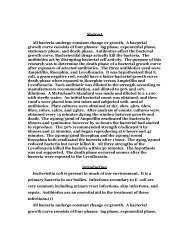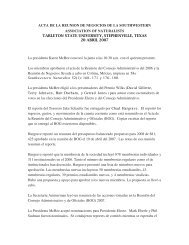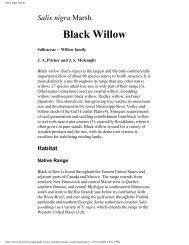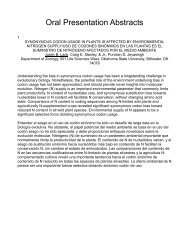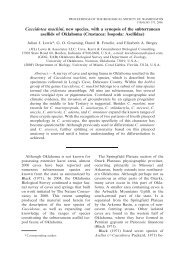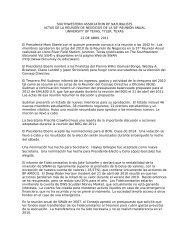Mary Masterman - Oklahoma Biological Survey - University of ...
Mary Masterman - Oklahoma Biological Survey - University of ...
Mary Masterman - Oklahoma Biological Survey - University of ...
You also want an ePaper? Increase the reach of your titles
YUMPU automatically turns print PDFs into web optimized ePapers that Google loves.
Raman Instrumentation<br />
4<br />
Raman systems are generally composed <strong>of</strong> several main parts, as follows.<br />
A. The excitation source (laser).<br />
Lasers make modern Raman feasible because they give a coherent beam <strong>of</strong> monochromatic light and can have very high power.<br />
They must be <strong>of</strong> sufficient intensity to produce the desired and detectable amount <strong>of</strong> Raman scatter, and they should be free <strong>of</strong><br />
extraneous bands. They should thus exhibit good wavelength stability and low background emission.<br />
The frequency <strong>of</strong> a Raman shift is independent <strong>of</strong> the laser wavelength used for excitation. This is an important concept in<br />
Raman. In Raman, unlike electronic spectroscopy, wavelengths are not normally measured in Angstroms or nanometers. Since the<br />
frequency shift, not the actual frequency, is what is important, Raman spectra are generally plots <strong>of</strong> intensity versus wavenumber:<br />
, where c is the speed <strong>of</strong> light in cm/s and v is the frequency in s^-1. (4) Since it is independent<br />
<strong>of</strong> the laser wavelength, the wavenumber will be the same for a 532 nm or a 785 nm laser. The wavelength difference for a<br />
particular band, however, is not necessarily the same. For instance, a wavenumber <strong>of</strong> 1000 cm^-1 for a 532 nm laser would result in<br />
a Stokes band ~30 nm away from the laser line. But the same wavenumber for a1064 nm laser would result in a Stokes band ~130<br />
nm away from the laser line.<br />
Intensity <strong>of</strong> the Raman signal is inversely proportional to the 4 th power <strong>of</strong> the laser wavelength (3):<br />
. It would seem,<br />
then, that laser radiation <strong>of</strong> a high frequency would be ideal. However, since samples tend to fluoresce at higher-frequency<br />
wavelengths, and since fluorescence is a much more efficient process than Raman, this is not necessarily true. Thus, infrared lasers<br />
have become increasingly popular in Raman, despite their low frequencies. On the other hand, it has also been demonstrated that at<br />
wavelengths under 260 nm, there is essentially no fluorescence interference (3); so ultraviolet lasers have the benefits <strong>of</strong> stimulating<br />
strong Raman scattering and not causing samples to fluoresce.<br />
B. System to irradiate sample and collect scattered light (three types <strong>of</strong> filters).<br />
Light from the laser is generally passed through an excitation filter in Raman systems. The excitation filter purifies the laser<br />
beam by permitting light only <strong>of</strong> a very small selected wavelength range to pass through, eliminating background emission (1).<br />
Excitation filters may be Short-Wave-Pass (only extraneous light <strong>of</strong> longer Stokes wavelengths than the laser is blocked) or Laser-<br />
Line (extraneous light <strong>of</strong> wavelengths shorter and longer than the laser is blocked) (5).<br />
After passing through an excitation filter, the laser beam is usually focused on the sample in order to increase the intensity <strong>of</strong> the<br />
electric field on the sample surface (the magnetic component <strong>of</strong> the electromagnetic radiation is generally not relevant to Raman)<br />
(4). Raman scattered light is then collected and passed through a barrier filter. The barrier filter prevents Rayleigh-scattered light <strong>of</strong><br />
the same wavelength as the laser form passing on to the slit <strong>of</strong> the spectrograph (the Rayleigh scattering is so much more intense<br />
than the Raman that it would saturate the CCD chip).



